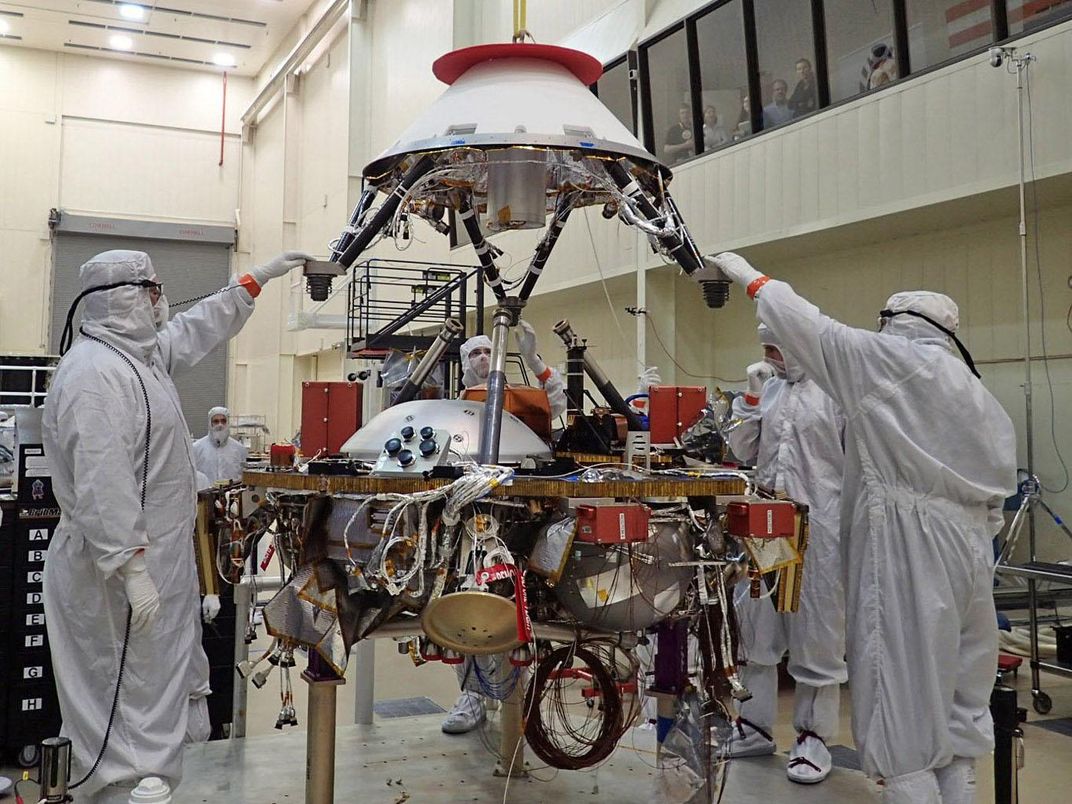Delayed InSight Mission to Mars Slated to Launch in 2018
With redesigned equipment, scientists hope to unearth how the Red Planet came to be
/https://tf-cmsv2-smithsonianmag-media.s3.amazonaws.com/filer/2e/7d/2e7d5b6f-0f67-48dd-ab4e-0e117b2c7317/insight.jpg)
Last Friday, NASA announced that the InSight Mission to Mars will commence after a two-year delay. The new launch period is slated for May 5, 2018 and will bring scientists new information about how rocky planets are formed.
"It's gratifying that we are moving forward with this important mission to help us better understand the origins of Mars and all the rocky planets, including Earth," says Geoff Yoder, acting associate director of NASA’s Space Mission Directorate in a release.
The delay is the result of a vacuum leak in the SEIS (Seismic Experiment for Interior Structure) instrument. Originally scheduled to launch in March 2016, the space agency hit pause on InSight this past December.
The extra time will allow NASA’s Jet Propulsion Laboratory to redesign the instrument’s vacuum container and the electrical components that caused the failure. The SEIS is particularly important: the measurements it takes form the core of the InSight Mission’s purpose. The vacuum failure was “a real blow” to the French space agency, CNES, which designed it, the agency’s president Jean-Yves Le Gall tells SpaceNews.
Going forward, CNES will focus on developing SEIS sensors and integrating them into the vacuum container, as well as fitting the SEIS unit into the lander, according to NASA.

The Phoenix Mars mission explored the planet’s surface, but now NASA wants to go deeper, exploring the planet’s inside. According to the mission overview, its goal is to study Mars in order to learn about how rocky planets form and evolve. They will also take a snapshot of Mars, capturing not only its seismic activity and temperature but also how it is pulled by the gravitational forces of the sun and its moons Phobos and Deimos.
The instrument was developed in an international collaboration and will be the first European seismometer on another planet, according to the Max Planck Institute. It can record information about seismic activity on the planet that will tell about its interior structure.
To work on Mars, a relatively cold planet that has regular giant dust storms and an atmosphere that is about 100 times thinner than that of Earth, the SEIS needs a perfect vacuum seal protecting its three instruments.
Although Mars and Earth are different on the surface, NASA says that studying one can tell scientists about the other, and about the two other rocky planets in our solar system—Venus and Mercury.
Mars also presents a “Goldilocks” opportunity for studying rocky planets, according to NASA. It’s big enough that it has a separate crust, mantle and core, but small enough that the history of the internal heating processes that created that separation is still visible.
The other planets in our solar system are known as Jovian (or Jupiter-like) planets. They include the gas giants Jupiter, Saturn, Uranus and Neptune.
"Our robotic scientific explorers such as InSight are paving the way toward an ambitious journey to send humans to the Red Planet," Yoder said. Neither of the other rocky planets in our solar system are potentially habitable.
A different NASA device, the Kepler telescope, has looked for roughly Earth-sized planets outside of our solar system since 2009, with 2330 confirmed planet sightings so far—majority of which are thought to not be habitable.
Another recent discovery was an Earth-sized planet orbiting Proxima Centauri, the closest star to our solar system, at the correct distance for it to potentially have liquid water. This discovery of such a close planet gives space-lovers great hope for future interstellar travel.
It’s an exciting time to be looking for habitable exoplanets—and last week’s announcement means scientists will soon know more about what they’re looking for.